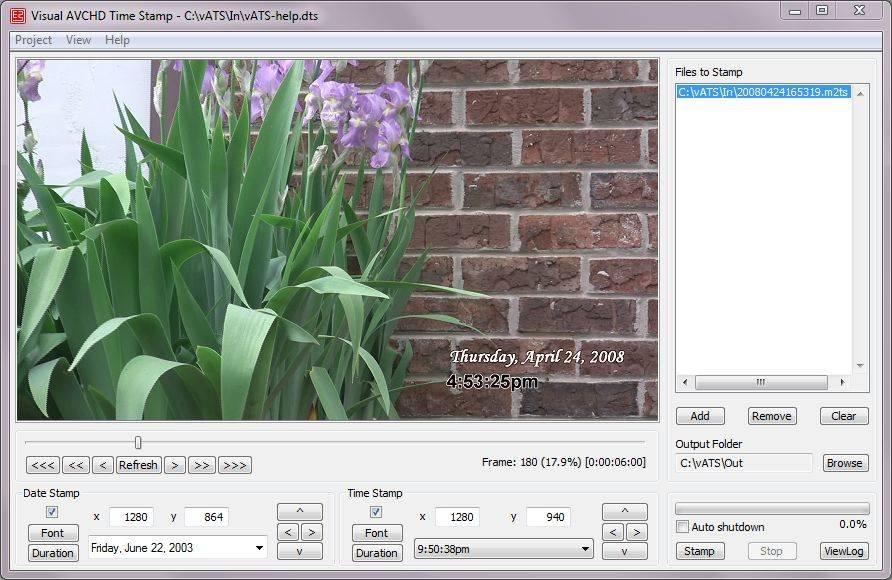Visual Avchd Timestamp Serial

Visual AVCHD Time Stamp is an advanced and rather intuitive Windows application that lets you embeds the date and time stamp of a video in its AVCHD file. It features a built-in video previewer and automatic PC shutdown, among other handy options.
When videos recorded on an AVCHD camcorder are captured into AVCHD files on a PC, the time codes (date/time when the tape was recorded) are transferred along with the video/audio data to the files. But the time codes are not visible when you view the AVCHD files. When you use video edit tools (e.g. Windows Live Movie Maker) to convert the AVCHD files to other files, the time codes get lost.
By using vATS, the time codes are extracted from the AVCHD files and superimposed onto the videos. This way the date/time will be visible when you view the stamped file, consequently other files made out of the stamped files will have date/time displayed.
A 2004 SONY FX-1E camcorder A camcorder is an electronic device originally combining a and a. The earliest camcorders were tape-based, recording onto videotape cassettes. In 2006, digital recording became the norm, with tape replaced by storage media such as mini-HD, microDVD, internal.
More recent devices capable of recording video are and primarily intended for still pictures; the term 'camcorder' may be used to describe a portable, self-contained device, with video capture and recording its primary function, often having advanced functions over more common cameras. Sony Betamovie BMC-100P is the first consumer camcorder. Released in 1983 for the Betamax format. It has no playback functionality and is only capable of recording originally designed for were large and heavy, mounted on special pedestals and wired to remote recorders in separate rooms. As technology improved, video recording was possible with compact video cameras and portable; a detachable recording unit could be carried to a shooting location.
Although the camera itself was compact, the need for a separate recorder made on-location shooting a two-person job. Rebustar azasha zhauabimen. Specialized were introduced by () and (, with ) releasing a model for mobile work.

Portable recorders meant that recorded video footage could be aired on the early-evening news, since it was no longer necessary to develop film. In 1983, Sony released the first camcorder, the system, for professional use. A key component was a single camera-recorder unit, eliminating a cable between the camera and recorder and increasing the camera operator's freedom. The Betacam used the same cassette format (0.5 inches or 1.3 centimetres tape) as the Betamax, but with a different, incompatible recording format. It became standard equipment for. Sony released the first consumer camcorder in 1983, the BMC-100P.
It used a Betamax cassette and rested on the operator's shoulder, due to a design not permitting a single-handed grip. That year, JVC released the first camcorder. Kodak announced a new camcorder format in 1984, the. Sony introduced its compact 8 mm format in 1985. That year,, and began producing camcorders using a full-size VHS cassette with a three-hour capacity.
These shoulder-mount camcorders were used by, industrial and college TV studios. Full-size Super-VHS (S-VHS) camcorders were released in 1987, providing an inexpensive way to collect news segments or other. Sony upgraded Video8, releasing the Hi8 in competition with S-VHS.
Digital technology emerged with the Sony, a device which recorded data and required a large amount of for its time. In 1992 introduced, the first digital video format with using the algorithm present in most commercial digital video formats.
In 1995 Sony, JVC, Panasonic and other video-camera manufacturers launched, which became a standard for home video production, independent filmmaking. That year, introduced (the first tapeless video recording system).
- воскресенье 10 февраля
- 17